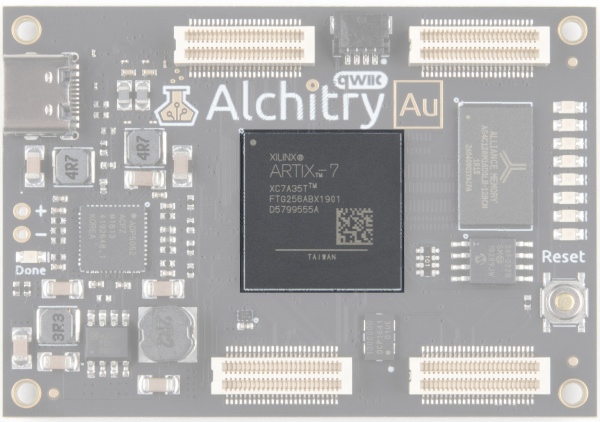How Does an FPGA Work?
Introduction
Let’s start at the beginning. What is an FPGA? Well, FPGA stands for Field Programmable Gate Array, which isn’t helpful in understanding what they are or do but we had to get that out of the way.
FPGAs belong to a class of devices known as programmable logic, or sometimes referred to as programmable hardware. Essentially, an FPGA doesn’t do anything itself but it can be configured to be just about any digital circuit you want. The magic here is that nothing physically changes. You simply load a configuration into the FPGA and it starts behaving like the circuit you wanted. No soldering, no jumper wires, no fuss. An FPGA can then be reconfigured to behave like another circuit, and another, and another. The configuration is RAM based which means it can essentially be reconfigured an unlimited number of times.
 |
 |
| Lattice iCE40 HX FPGA highlighted on the Alchitry Cu Board | Xilinx Artix 7 FPGA highlighted on the Alchitry Au Board |
Even though we talk about using FPGAs to create digital circuits, you don’t typically draw schematics to create designs for them. The size and complexity of the circuits FPGAs can contain would become very cumbersome should you actually draw out a schematic. Instead, you can describe the behavior of the circuit you want and the tools will use this to create a circuit that matches that behavior.
In this regard it can feel like programming since you are just typing text. However, the fundamental implementation is drastically different as you are creating hardware.
If creating hardware with text seems like magic, don’t worry. The way they work is actually quite simple in concept and in this tutorial we are going to really break it down.
Suggested Reading
In this tutorial we are going to explore what an FPGA is and how they work. I’m going to assume you have a decent understanding of electricity (voltage, current, etc) and binary values. Everything else will be quickly built upon the basics. This is intended as an overview of what an FPGA is and its fundamental design, not a guide to designing your own.
If you aren’t familiar with the following concepts, we recommend checking out these tutorials before continuing.